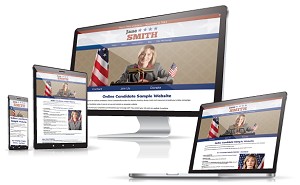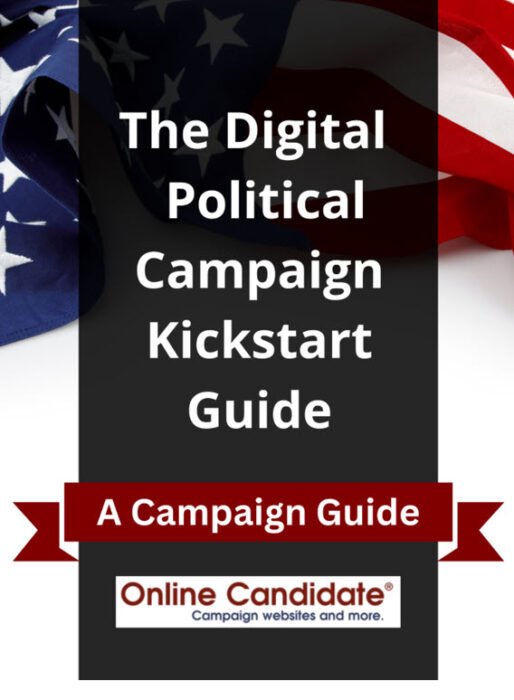Critical Elements of a Campaign Website Header
 Web users make snap decisions about the quality of a web page, so a nice design is critical for making an initial positive impression. The first part of a website that typically attracts the eye is the site header. Below are the most common features of successful politicalwebsite header images.
Web users make snap decisions about the quality of a web page, so a nice design is critical for making an initial positive impression. The first part of a website that typically attracts the eye is the site header. Below are the most common features of successful politicalwebsite header images.
Candidate Photo: A candidate head shot is the most common feature in a campaign site header. Must be the nature of candidates, but there are few politicians who did not want their photo front and center. The best shots to work with are those with the subject in front of a solid color that contrasts with their clothing. This makes it much easier to crop and edit the image.
Colors and Fonts: The colors of the header and website should be consistent with the color scheme of any other campaign material that will be use. Consistency builds familiarity.
Location: This one gets missed sometimes, particularly the location. It’s great that the site is about ‘Smith for Mayor’, but mayor of where? Never assume that a visitor knows where you are located. Your municipality should be included the header. For SEO purposes, you should also include both the municipality and state somewhere in the body text of your pages.
Sample Website Header Designs
See our political website design examples.
Slogan or Quote: This is optional, but if you have a great campaign slogan, why hide it? Incorporate it into the header image.
Landmarks: Readily identifiable natural or man-made landmarks make a great addition to a header, particularly when used as a background. State flags or seals also make for good backgrounds, but if you plan to use them, make sure you can do so.
The size of header, particularly its height, can vary from site to site. When we started creating Online Candidate back in 2004, most of our sites were quite narrow, perhaps a hundred pixels tall. Today we tend to make them as least twice as tall, and a candidate head shot now usually includes the shoulders and chest. Part of this is simply keeping up with online design trends, and also the fact that the average screen resolution is higher than it used to be.
Learn more about our Campaign Website Packages to create an effective, professional web presence that helps win elections. Our Regular and Enhanced Website Packages include custom design!
Creating an Online Political Press Kit
 Online political press kits are helpful in that basic campaign information can be kept in one place, and the information is easily accessible. Press kit material can be added to its own section on your campaign website or incorporated into your contact page.
Online political press kits are helpful in that basic campaign information can be kept in one place, and the information is easily accessible. Press kit material can be added to its own section on your campaign website or incorporated into your contact page.
Traditionally, digital press kits are built into a series web pages where the goal is to advertise the site. Using that format on a campaign website is a little redundant, since you are not looking for advertisers, and the point of the site is to sell the candidate. Instead, a campaign press kit is designed to create digestible information that can be easily downloaded by voter and reporters and incorporated into media coverage about your campaign.
So what goes into a political online press kit? It depends, really. Unlike a physical press packet, an online press kit can be broken up to be downloaded in part or in whole. PDFs work well as a common file format for documents.
You can save your files as PDFs through Word, or you can convert them through a free tool like PrimoPDF. Images can be grouped together and compressed into ZIP files. WinZip is a popular compression program, but there are free alternatives available such as jzip.
A political campaign press kit includes:
- A cover letter describing the candidate and campaign.
- A candidate biography. Don’t forget to add a photo and related web links.
- Press releases from the organization.
- Digital copies of logos, brochures, flyers, etc.
- Photographs of the candidate and events from the campaign trail. Offer several versions for download. Low-res files can be used for web, but print requires larger images with higher resolution.
- Newspaper or other media excerpts. Rather than reprinting the material outright, you could create a document or PDF file with links.
- A Question and Answer sheet covering the major issues. This should include standard platform information and cover basic questions.
Avoid fluff about how great the candidate is. Keep the press material professional and up to date. You don’t need to necessarily link to your files. You can keep them private and only provide direct download links when necessary.
A PR kit can also be created for events. Again, this is packet of information meant to inform the media about a fundraiser, meeting or public debate. This may contain much of the same content as your regular kit, but tailored with additional background or press release information about the event.
To quickly get your material into the hands of the media, reach out early. Find out what reporters cover your area and send them a quick introduction and contact information, letting them know where they can find up-to-date information about your campaign. Remind reporters of your online press kit following candidate interviews or when you are submitting press releases. Anything you can do to make a journalist’s job easier is helpful and, if you’re lucky, may lead to better media coverage.
Download our brochure templates to add a professional edge to your campaign literature – or view all of our Digital Products.
Sign of the Times for Political Candidates – Best of Posts
 No matter the changes or trends in politics, yard signs were and still remain a mainstay of political campaigning. We’ve written about signage several times over the years. For newer readers who may have missed some posts, you’ll find them all here in once place!
No matter the changes or trends in politics, yard signs were and still remain a mainstay of political campaigning. We’ve written about signage several times over the years. For newer readers who may have missed some posts, you’ll find them all here in once place!
Common Campaign Sign Questions
Here are some common questions and answers about political yard signs. Learn about the sizes, types and more…
Campaign Yard Sign Design Tips
Over time, a single campaign sign can be seen by hundreds or even thousands of people. Multiply that effect by the total number of yard signs promoting a campaign, and you have a powerful way to build candidate name recognition.
Leveraging Campaign Yard Signs Online
In a tight race, you are always trying to get the edge over your opponent. One way to stand out is to combine offline campaign tactics with online ones. When field and the campaign’s web team are working together, great things happen. Campaigns can even leverage the humble yard sign to connect with voters.
Great Uses For Old Campaign Signs
Once the election is over, the campaign signs remain. Here are some creative ways to get rid of your signs without throwing them out.
10% Off on Super Cheap Signs. Use Code: ONLCAN10
.Com or .Org for Political Campaigns? How to Choose Your Domain Name
When it comes to choosing a domain name for your political campaign website, your choice matters more than you might think. One of the first decisions your campaign must make is which domain name and extension to use. Get it wrong, and you risk confusing voters, losing traffic – or worse, sending supporters to the wrong site.
Anyone can register a top-level .com or .org domain name. While the .com extension is the most familiar, .org is often used for non-profit organizations, including political campaigns. (.net is also available, but it’s not widely used for political campaigns and tends to be less memorable.)
In terms of search engine optimization (SEO), it doesn’t matter much whether you use a .com or a .org extension. Both are treated equally by search engines. But in the minds of voters, .com tends to be the default, and .org may suggest a more cause-based or nonprofit identity.
Tip: You can get a free .com domain with any Online Candidate campaign website package.
Should You Register Both .Com and .Org Domain?
Short answer; you probably don’t need both. But if your campaign organization wants to register a .org name and use that as your primary domain name, then make sure the you also own the .com extension. Many visitors will instinctively type “.com” instead of “.org” when searching for your site. If you only own the .org and not the .com, they could end up on someone else’s site—or no site at all.
By owning both versions, you can redirect one to the other. For example, if someone types in yourwebsite.com, they can automatically be redirected to yourwebsite.org. That way, you won’t lose potential supporters to a mistyped URL.
If the .com domain you want is already taken and you really want it, it might be worth trying to purchase the name. This can get expensive, though. For campaigns on a budget, it may be better to brainstorm a new domain name rather than overpay.
Tips for Choosing a Good Campaign Domain Name
When selecting a domain name for your campaign, keep it short, memorable, and relevant. Ideally, use your full name or the position you’re running for. For example, janedoeformayor.com is clear and specific. Avoid using hyphens, numbers, the year, or complicated words that are hard to spell. Keep in mind how the domain will look on signs, social media, and in print. If possible, register multiple versions or common misspellings to redirect to your main site.
Tip: If you’re running in a local race, consider including your city or district name, like smithforalbany.com, to make it easier for voters to find you in search results.
Watch Out for Domain Squatting
If you delay registering your domain, someone else might grab it – either unintentionally or to resell it at a high price. This practice, called domain squatting, is more common than you’d think—especially during election season. Worse, your opponent could register a similar domain and use it for their own messaging or to confuse voters. That’s why registering early and considering related or alternate domain names is more than just good campaign protection.
Important: Always register your campaign domain name before printing signs, mailers, or publishing social media ads. Nothing looks worse than advertising a domain that doesn’t exist—or one you don’t control.
Protecting your privacy
WHOIS is a public directory that maintains a record of all domain registrations. It includes registrant details such as your name, email, phone number, and mailing address. Once registered, your inbox may fill up with spam offering everything from SEO services to website design.
Why? Because your contact info is publicly visible—unless you opt for domain privacy protection.
Adding ID Protect when registering your domain keeps your personal information hidden from spammers and telemarketers. Without it, your private contact information becomes searchable by anyone.
Keeping your domain after the election
If you think you are going to run for office again in the next election cycle, you may want to keep the domain name, even if your website goes offline. The cost is about $25 a year. And this keeps your domain from lapsing and giving someone else the opportunity to register it for themselves.
Considering .REPUBLICAN or .DEMOCRAT Domains?
Looking for something beyond the typical .com or .org?
.REPUBLICAN and .DEMOCRAT domain names instantly communicate your party affiliation to voters. These politically branded domains can boost your visibility and clearly signal your identity to visitors and search engines alike.
Right now, you can register a .DEMOCRAT or .REPUBLICAN domain with Online Candidate. Just be aware that premium domain names may be priced higher—or unavailable—depending on demand.
Whatever domain you choose, secure yours early before someone else does.
Additional Resources:
- Free Download: Political Website Domains and Hosting – What You Need To Know
- Is Your Campaign Website Domain Really Yours?
Ready to get started? Register your domain, set up hosting and get the tools you need to WIN your election. Check out our affordable Political Website Packages.
Website Promotion for Local Candidates
 The 1990s myth, “If you build a web site, they will come,” is still a commonly believed by companies, organizations, and people running for office who are new to digital marketing. The reality, however, is that people won’t come to your website unless you promote your website both online and offline.
The 1990s myth, “If you build a web site, they will come,” is still a commonly believed by companies, organizations, and people running for office who are new to digital marketing. The reality, however, is that people won’t come to your website unless you promote your website both online and offline.
Here are few basic tips for promoting a new website for a candidate.
Offline promotional materials
Prominently include your campaign website domain name in EVERY print piece distributed by your local campaign – flyers, press releases, posters, yard signs, buttons, banners, TV and radio ads, and anything else related to your campaign. Always let the media know that this additional material is available on your online campaign press kit. (Odds are, they will use it!)
Use your email list
By starting your site early, you can accumulate more e-mail addresses from your supporters and voters. Using the mail list to keep in regular (but not TOO frequent) contact helps get your word out and keeps supporters informed. Always provide a link back to your campaign website, and suggest that the recipient forward your newsletter e-mail to others.
Smart linking
Reciprocal linking is often used by small to midsized websites as an inexpensive way to increase visitor traffic and link popularity with search engines. (You DID create a Google account for your campaign, didn’t you?) If a newspaper writes an article about you, make sure the reporter knows your website address. When the article is published, do a short writeup about the article on your site blog and link out to it.
Are there local or regional web sites that would agree to link to your site? What about other local candidates from your own party? Ask other groups campaigning for similar causes to put a link from their website to yours, and offer to do the same for them. Reciprocate links, and you can both benefit from the cross-traffic and bring exposure to others interested in similar issues.
Viral marketing
“Viral marketing” refers to the phenomenon of people sending information about your site to other people, who then in turn forward it on to others, and so on! Viral marketing can be very powerful.
Below are examples of viral marketing that are easily implemented:
- Share buttons: Share buttons that allow your content to be shared to social media sites like Facebook and Twitter is an example of viral marketing.
- Newsletters: Encourage viral marketing by putting a line at the end of your campaign email newsletters asking people to forward your newsletters on to others.
- E-mail signature: Most e-mail programs allow you to create a “signature” that’s added to the bottom of every outgoing e-mail message. Make sure your campaign staff’s e-mail accounts contain a signature that links back to the campaign website.
Consider online advertising
While banner ads often garner “click-through” rates of less than one-half of one percent, local political ads often perform much better – especially when they appear on a local newspaper website near election time. Local newspaper websites are your best bet for direct online advertising. Newspapers already have a large built-in audience of potential constituents. If you are going to do any online advertising, pay-per-click text ads and newspaper advertising are your best bets.
Most publishers will design a creative ad (“creative”) for you, although many campaign organizations submit their own creatives or do multiple creatives, each focusing on a different topic. Hiring a designer to do an online ad for you varies, depending on what kind of creative you need.
We provide affordable campaign websites for candidates. Easy to start, easy to maintain, and includes tools and resources to help your online marketing.
An Alternative To Wordpress for Political Campaign Websites

WordPress is a very popular content management system (CMS) that runs about a quarter of all websites as of this writing.
Many political campaigns use WordPress as their website CMS. It’s a powerful solution, but whether it’s the right solution for your campaign depends on your needs, budget, and technical abilities.
WordPress uses themes for design. There are thousands of free and low-priced ones available. There are also a number of political WordPress themes available. However, all themes require installation and customization. If you purchase a theme with a lot of bells and whistles, the customization can take quite a bit of time.
WordPress plugins provide additional functionality without requiring custom programming. Again, there are thousands of free and paid plugins available. They may include forms, calendar features, and so on. However, for plugins to work, they must be installed, configured for use, and kept up to date.
While the WordPress software may be open source (and free) and themes are fairly inexpensive, getting the site configured and customized takes a lot of time. For a person without technical skills, there can be a steep learning curve.
You can get your site built on the cheap. However, you usually get what you pay for, so you might not want to put your online presence in the hands of an inexperienced developer or with a poor design. A WordPress template can become a mess in the wrong hands, or the site may not be optimized for search engines.
Another downside to WordPress is that you need to perform backups, security updates, and any necessary upgrades yourself. If you don’t keep up with updates, you run the risk of having your site hacked. Because WordPress powers so much of the web, it’s the biggest target for online hackers.
So, is a WordPress campaign website worth it? Ultimately, that’s up to you. It’s certainly not a bad choice, but only if the site is properly designed and configured.
Though we now offer WordPress Campaign Websites, the Online Candidate platform has been developed and refined to make websites simple to update, even for people with little technical skill. It contains built-in tools and functionality specific to political candidates. The templating system is built-in and is simple but very flexible. Even our custom designs are affordable because we have a fast and efficient production process, allowing us to pass on the cost savings to our clients.
Learn more about our Online Candidate political website platform and learn why hundreds of campaigns use us every election cycle.










